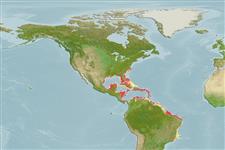Environment: milieu / climate zone / depth range / distribution range
पारिस्थितिकी
समुद्री प्रवाल-भित्ति संयुक्त. Tropical; - 23°S
Western Atlantic: southern Florida, USA and Bahamas to the Antilles and Brazil (Ref. 5521).
आकार / वज़न / Age
Maturity: Lm ? range ? - ? cm
Max length : 15.0 cm TL पुल्लिंग / अलिंग; (Ref. 7251)
Dark red-brown above; side pale yellow or cream, with small, dark red-brown spots; belly creamy yellow. 3 spines on vertical edge of preopercle (Ref. 26938).
A solitary species (Ref. 26340) inhabiting sandy bottom strewn with rocks (Ref. 5521). Rarely observed on reefs (Ref. 13442). Like other soapfishes, it has special skin glands that produce an irritating, mildly toxic slime (Ref. 26938).
Life cycle and mating behavior
Maturities | पुनरुत्पत्ति | Spawnings | Egg(s) | Fecundities | लार्वा
Robins, C.R. and G.C. Ray, 1986. A field guide to Atlantic coast fishes of North America. Houghton Mifflin Company, Boston, U.S.A. 354 p. (Ref. 7251)
IUCN Red List Status (Ref. 130435)
Threat to humans
Harmless
Human uses
साधन
Special reports
Download XML
इंटरनेट स्रोत
Estimates based on models
Preferred temperature (Ref.
123201): 24 - 28.1, mean 27.3 °C (based on 703 cells).
Phylogenetic diversity index (Ref.
82804): PD
50 = 0.5010 [Uniqueness, from 0.5 = low to 2.0 = high].
Bayesian length-weight: a=0.01148 (0.00451 - 0.02922), b=3.06 (2.84 - 3.28), in cm total length, based on LWR estimates for this (Sub)family-body shape (Ref.
93245).
Trophic level (Ref.
69278): 3.7 ±0.6 se; based on size and trophs of closest relatives
Fishing Vulnerability (Ref.
59153): Low vulnerability (10 of 100).
Nutrients (Ref.
124155): Calcium = 79 [43, 154] mg/100g; Iron = 0.682 [0.353, 1.179] mg/100g; Protein = 18.5 [16.7, 20.2] %; Omega3 = 0.185 [0.114, 0.294] g/100g; Selenium = 26.4 [14.5, 49.4] μg/100g; VitaminA = 146 [48, 490] μg/100g; Zinc = 1.37 [0.92, 2.00] mg/100g (wet weight);
